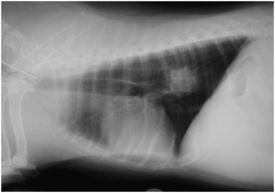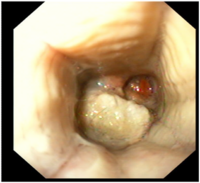Oesophageal Foreign Body
| This article is still under construction. |
Description
Although many foreign objects are regurgitated from or transported through the gastrointestinal tract, those that are too large or have sharp points may remain lodged causing mechanical obstructions. Foreign bodies that become lodged in the oesophagus often have sharp points and include bones, fish hooks, needles, sticks and toys. The most common foreign bodies found in dogs are bones and bone fragments, particularly pieces of lamb vertebrae. In cats, toys are the most common objects to become lodged.
Obstructions occur most commonly at natural areas of narrowing along the oesophagus, particularly the thoracic inlet, heart base and distal high pressure zone, just oral to the the lower oesophageal sphincter.
The severity of oesophageal damage is dependent on the size and angularity of the foreign body, as well as the duration of obstruction. Even if the object is dislodged, there is a risk that residual inflammation may lead to the formation of strictures at the site of obstruction. In severe cases, the oesophagus may rupture into the mediastinum causing mediastinitis and possibly tension pneumothorax. Sharp objects (such as fish hooks) which lodge over the heart base may occasionally lacerate the great vessels passing from the heart and cause fatal internal haemorrhage.
Signalment
Although any age group may be affected, young dogs of the small terrier breeds are over-represented. It has been suggested that certain breeds (the Border Terrier) may have delayed maturation of the systems that control oesophageal motility, increasing their risk of developing oesophageal foreign bodies in the first year of life.
Diagnosis
Clinical Signs
Animals may have a history of ingestions of bones or other objects. Typical signs include
- Acute onset of regurgitation or retching with hypersalivation/ptyalism.
- Animals may be unable to swallow (dysphagia) or may show pain on swallowing (odynophagia).
- If the object has lodged in the cervical oesophagus, a mass may be palpable over the left ventral neck.
Diagnostic Imaging
Plain radiographs of the chest may reveal oesophageal foreign bodies that are sufficiently radiodense. Poultry bones or other, more radiolucent, items may be more difficult to visualise. Signs of oesophageal perforation may be evident and it is important to assess these carefully. They may include:
- Pneumothorax, including tension pneumothorax in which the contents of the mediastinum will be pushed to one side of the chest. Air may also be observed in the retroperitoneal space if it escapes between the crura of the diaphragm.
- Pleural effusion, which may indicate a developing pyothorax.
- Pneumomediastinum or presence of fluid in the mediastinum.
Contrast radiography is rarely necessary but may be used to identify radiolucent foreign objects. Contrast agents must be used with caution if there is suspicion of oesophageal perforation.
Oesophagoscopy can be used to provide a definitive diagnosis of an oesophageal foreign body.
Treatment
Oesophageal foreign bodies should be removed promptly to reduce the extent of mucosal damage, ulceration, perforation and subsequent stricture formation.
Endoscopic removal with grasping forceps is the method of choice for removing foreign bodies unless:
- The object is too firmly lodged to pull free.
- Radiographs of the chest suggest that the oesophagus has been perforated.
If the object too large to be safely removed through the mouth, it may be possible to push it into the stomach and remove it surgically via a gastrotomy.
If endoscopic removal is not possible, the foreign must be removed surgically. The approach used depends on the exact location of the object:
- In the cervical oesophagus, a ventral midline cervical approach is made and the trachea is retracted to the right to expose the oesophagus.
- In the thoracic oesophagus, a lateral (intercostal) thoracotomy or median sternotomy is performed. As the chest cavity is entered in either approach, the patient must be ventilated.
- In the abdominal oesophagus, a ventral midline coeliotomy is performed.
The affected portion of the oesophagus is isolated with loops of umbilical tape and packed off from the thorax with moist laparotomy swabs. A longitudinal incision is made (to reduce the likelihood of subsequent stricture formation) and the foreign body is removed. The incision can then be closed with simple appositional sutures which must include the submucosa (the holding layer throughout the gastro-intestinal tract).
Aggressive medical treatment should be initiated after surgical removal to reduce the likelihood of stricture formation. This should include:
- withdrawal of oral food for 24-48hrs
- inspection of the oesophageal mucosa to assess for any damage.
- thoracic radiographs to look for pneumothorax caused by oesophageal perforation.
- antibiotic therapy.
- administration of gastroprotective drugs such as H2 receptor antagonists or proton pump inhibitors.
- prokinetic agents.
- gastrotomy feeding tube.
Prognosis
Animals with oesophageal foreign bodies without perforation carry a good prognosis. Those with oesophageal perforation carry a guarded prognosis depending on the degree of thoracic contamination.
References
- Hall, E.J, Simpson, J.W. and Williams, D.A. (2005) BSAVA Manual of Canine and Feline Gastroenterology (2nd Edition) BSAVA
- Merck & Co (2008) The Merck Veterinary Manual
- Nelson, R.W. and Couto, C.G. (2009) Small Animal Internal Medicine (Fourth Edition) Mosby Elsevier.

